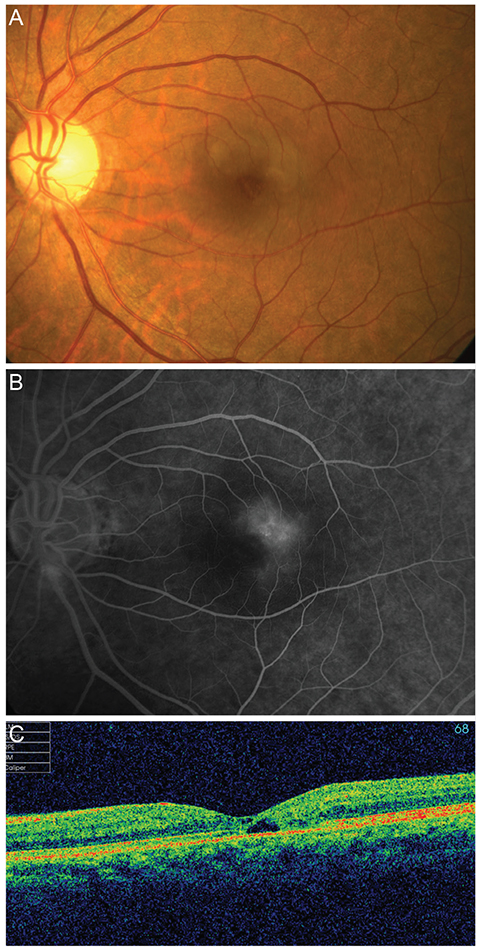Korean J Ophthalmol.
2015 Jun;29(3):155-159. 10.3341/kjo.2015.29.3.155.
Demographic Features of Idiopathic Macular Telangiectasia in Korean Patients
- Affiliations
-
- 1Department of Ophthalmology, Dongguk University Ilsan Hospital, Goyang, Korea. blueretinaoh@gmail.com
- 2Department of Ophthalmology, Korea University College of Medicine, Seoul, Korea.
- KMID: 2363752
- DOI: http://doi.org/10.3341/kjo.2015.29.3.155
Abstract
- PURPOSE
To investigate the clinical and demographic features of idiopathic macular telangiectasia (MacTel) in Korean patients since the introduction of spectral domain optical coherence tomography (SD-OCT).
METHODS
We reviewed medical records of patients who were diagnosed with MacTel from 2009 to 2013. All patients underwent fluorescein angiography and SD-OCT and were classified as type 1 or type 2 according to the classification system proposed by Yannuzzi.
RESULTS
Over a period of 5 years, 4 (18.2%) patients were diagnosed with type 1 MacTel and 18 (81.8%) patients were diagnosed with type 2 MacTel. All patients with type1 MacTel were male, and their mean age was 51 +/- 8.6 years. Among patients with type 2 MacTel, 3 (16.7%) were male, 15 (83.3%) were female, and the mean age was 60 +/- 13.6 years. Whereas all type 1 MacTel patients had either metamorphopsia or mild scotoma, of the 18 patients with type 2 MacTel, only 4 (22.2%) had those symptoms, 10 (55.6%) complained of only mild visual impairment, and the other 4 (22.2%) had no symptoms. Intraretinal cystoid spaces were observed in 26 (72.2%) of 36 eyes with type 2 MacTel by SD-OCT. These cystoid spaces had irregular boundaries and did not correspond to angiographic leakages.
CONCLUSIONS
Type 2 MacTel was most common in the present study. The wider availability of SD-OCT may have contributed to the diagnosis of type 2 MacTel. Type 2 MacTel may be more prevalent than type 1 in Koreans, which corresponds to the results of Western countries.
Keyword
MeSH Terms
Figure
Reference
-
1. Engelbert M, Chew EY, Yannuzzi LA. Macular telangiectasia. In : Ryan SJ, editor. Retina. 5th ed. London: Saunders/Elsevier;2013. p. 1050–1057.2. Gass JD, Oyakawa RT. Idiopathic juxtafoveolar retinal telangiectasis. Arch Ophthalmol. 1982; 100:769–780.3. Gass JD, Blodi BA. Idiopathic juxtafoveolar retinal telangiectasis: update of classification and follow-up study. Ophthalmology. 1993; 100:1536–1546.4. Yannuzzi LA, Bardal AM, Freund KB, et al. Idiopathic macular telangiectasia. Arch Ophthalmol. 2006; 124:450–460.5. Aung KZ, Wickremasinghe SS, Makeyeva G, et al. The prevalence estimates of macular telangiectasia type 2: the Melbourne Collaborative Cohort Study. Retina. 2010; 30:473–478.6. Klein R, Blodi BA, Meuer SM, et al. The prevalence of macular telangiectasia type 2 in the Beaver Dam eye study. Am J Ophthalmol. 2010; 150:55–62.7. Lee SW, Kim SM, Kim YT, Kang SW. Clinical features of idiopathic juxtafoveal telangiectasis in Koreans. Korean J Ophthalmol. 2011; 25:225–230.8. Chang YI, Lee JG, Kim TW, Lee EK. The clinical manifestations and treatments of parafoveal telangiectasis. J Korean Ophthalmol Soc. 2004; 45:576–584.9. Drexler W, Fujimoto JG. State-of-the-art retinal optical coherence tomography. Prog Retin Eye Res. 2008; 27:45–88.10. Gabriele ML, Wollstein G, Ishikawa H, et al. Optical coherence tomography: history, current status, and laboratory work. Invest Ophthalmol Vis Sci. 2011; 52:2425–2436.11. Gillies MC, Zhu M, Chew E, et al. Familial asymptomatic macular telangiectasia type 2. Ophthalmology. 2009; 116:2422–2429.12. Charbel Issa P, Gillies MC, Chew EY, et al. Macular telangiectasia type 2. Prog Retin Eye Res. 2013; 34:49–77.13. Heeren TF, Holz FG, Charbel Issa P. First symptoms and their age of onset in macular telangiectasia type 2. Retina. 2014; 34:916–919.14. Finger RP, Charbel Issa P, Fimmers R, et al. Reading performance is reduced by parafoveal scotomas in patients with macular telangiectasia type 2. Invest Ophthalmol Vis Sci. 2009; 50:1366–1370.15. Charbel Issa P, Helb HM, Rohrschneider K, et al. Microperimetric assessment of patients with type 2 idiopathic macular telangiectasia. Invest Ophthalmol Vis Sci. 2007; 48:3788–3795.16. Charbel Issa P, Holz FG, Scholl HP. Metamorphopsia in patients with macular telangiectasia type 2. Doc Ophthalmol. 2009; 119:133–140.17. Clemons TE, Gillies MC, Chew EY, et al. The National Eye Institute Visual Function Questionnaire in the Macular Telangiectasia (MacTel) Project. Invest Ophthalmol Vis Sci. 2008; 49:4340–4346.18. Koizumi H, Iida T, Maruko I. Morphologic features of group 2A idiopathic juxtafoveolar retinal telangiectasis in three-dimensional optical coherence tomography. Am J Ophthalmol. 2006; 142:340–343.19. Oh JH, Oh J, Togloom A, et al. Characteristics of cystoid spaces in type 2 idiopathic macular telangiectasia on spectral domain optical coherence tomography images. Retina. 2014; 34:1123–1131.20. Barthelmes D, Sutter FK, Gillies MC. Differential optical densities of intraretinal spaces. Invest Ophthalmol Vis Sci. 2008; 49:3529–3534.
- Full Text Links
- Actions
-
Cited
- CITED
-
- Close
- Share
- Similar articles
-
- Macular GCIPL Thickness in Idiopathic Macular Telangiectasia Type II
- Combination Therapy with Photodynamic Therapy and Intravitreal Bevacizumab in Idiopathic Macular Telangiectasia Type I
- A Case of Bilateral Macular Hole in a Patient with Bilateral Macular Telangiectasia
- Subthreshold Micropulse Yellow Laser (577 nm) for Idiopathic Macular Telangiectasia Type 1 Resistant to Intravitreal Injection
- The Histopathologic and Clinical Features of Idiopathic Macular Hole



